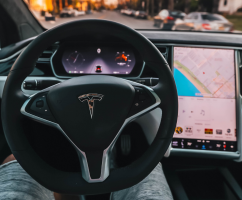
— Tesla touchscreen failures have caused the government to upgrade and expand an investigation into media control unit (MCU) failures that cause the screens to go black, leaving drivers without important features.
The National Highway Traffic Safety Administration (NHTSA) opened an investigation in June following complaints about touchscreen failures that resulted in backup camera failures, as well as failures of multiple features drivers need.
In addition to backup camera image failures, a driver will also lose heating and cooling controls while advanced driver assistance support and the Autopilot system will also be affected. In addition, a driver may lose audible chimes, driver sensing and other alerts.
The June investigation focused on 2012-2015 Tesla Model S cars equipped with NVIDIA Tegra 3 processors with integrated 8GB eMMC NAND flash memory devices. But during the investigation NHTSA learned the same touchscreens with the same processors were used in 2012-2018 Model S and 2016-2018 Model X vehicles.
Tesla Touchscreen Failure Complaints and Warranty Claims
The government also learned about 7,777 touchscreen failure warranty claims and 4,746 non-warranty claims related to touchscreen replacements. Tesla also sent data to NHTSA indicating nearly 2,400 touchscreen complaints had been received.
After adding up the numbers, safety regulators determined touchscreen failure rates were above 30% and increasing failures were reported after the touchscreens were three to four years old.
According to Tesla, 159,000 Tesla Model X and Model X vehicles are equipped with the NVIDIA Tegra 3 processors with integrated 8GB eMMC NAND flash memory devices.
The automaker says the devices have limited lifespans based upon the number of program/erase cycles, for which the eMMC controller has no way to recover. The only recovery is a replacement of the eMMC devices by replacing the MCU assemblies or visual control module subcomponents.
Tesla recently announced a warranty program for Model S and Model X vehicles built before March 2018, and the automaker has sent over-the-air updates to the vehicles due to touchscreen failures.
"These updates include firmware changes to reduce memory usage of the subject memory card, improve eMMC error correction and storage management strategies, changing the control logic for turn signal activation, and defaulting the HVAC system to Auto (71.6F) for drives after MCU failure to address windshield defogging." - NHTSA
However, Tesla says touchscreen failures will likely continue as the flash memory is used, finally causing 100% of the touchscreens to fail in 2012-2018 Tesla Model S and 2016-2018 Tesla Model X vehicles.
CarComplaints.com will update our website with results of the Tesla touchscreen investigation.




